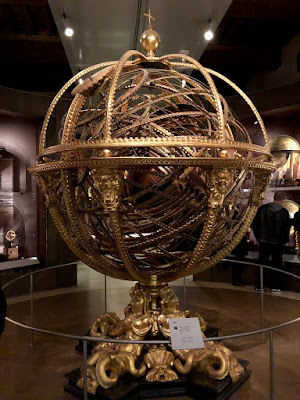I did spend 9 days in Florence, so of course there will be multiple posts. I promise to continue on to Siena, Montalcino, and Lucca after this one.
We've (sort of) covered the Bargello, the Uffizi, the and Boboli Gardens. And some food and wine.
The other two big visits I made were to the Pitti Palace and the Museo Galileo.
 |
| Inner Courtyard of the Pitti Palace |
The Pitti Palace was built in 1457 by Luca Pitti, a banker who didn't want to take second seat to the Medici, and so built on as grand a scale as possible. In a bit of irony, the Medici bought the Palazzo in 1549 and kept improving it until the last Medici Grand Duke of Tuscany died in 1737. They amassed a huge collection of art of the period. After the Medici Grand Dukes died out, the Hapsburg-Lorraine Grand Dukes took over until 1860 (with a couple interruptions). In the late 18th century, Napoleon used it for a short period and the Bourbon-Parma Etruria kings also. When Italy became a unified country, it was home to the new King of Italy, Vittorio Emmanuelle II. His son, Vittorio Emmanuelle III, donated the palace and its contents to the Italian people.
 |
| One of the 28 rooms in the Palatine Gallery |
I thought the Uffizi Galleries were large and had a lot of stairs to climb. The Pitti Palace is the largest museum in Florence comprising a number of different Galleries:
- Palatine Gallery is a fabulous collection of many paintings by Raphael, Titian, Peter Paul Reubens, Filippo Lippi, Caravaggio, Giogione, Verrochio, Veronese, Fra Bartolomeo, etc.
- Royal Apartments
- Gallery of Modern Art (not really so modern--these are collected works from the mid-1700s to the very early 1900s)
- Grandukes Treasury
- Porcelain Museum. This museum is actually in a building at the top of the Boboli Gardens.
- Costume Gallery (closed while I was there)
- Carriages Museum
In keeping with the theme of highlighting the unusual...
 |
| Orchestrion by Viennese workshop and Christian Seyffert 1821 |
The orchestrion was made in 1821 by Christian Seyffert, a successful Viennese clockmaker in the first half of the 1800s. By 1831, he had improved it to contain a music roll which allowed the mechanism to play the aria in the final Rondò in Vincenzo Bellini's La Sonnambula. Cool, yes?
 |
| Pietro Tenerani, Psiche Abbandonata, 1819 |
Psyche might have been abandoned in this statue by Pietro Tenerani, but Psyche's wings are a wonder.
 |
| Center: Lorenzo Viani, Self-portrait, c 1910-1912 |
For some reason Viani's bow tie reminds me of Gustav Klimt. These are in the Modern Art Gallery at the Pitti.
 |
| Arturo Checchi, Coperta Rossa (red cover), 1912 |
The heavy application of paint gives this a tactile look. There were several in this mode.
 |
| View from one end of the Modern Art Gallery to the other |
Just to provide some perspective on the size of these galleries, you can see doorway after doorway fading into the distance. Each doorway enters a room with around 10-20 pictures. Room after room after room....
And finally the Galileo Museum. This museum has some artifacts associated with Galileo, but while the name would seem to indicate that it is mostly focused on Galileo, it is really mostly a museum on the development of science and the instruments used in that development from the 16th to the beginnings of the 20th centuries.
 |
| A small sample of instruments |
Of course there are telescopes, but also scales, clocks, electrostatic devices, etc.
 |
| A few clocks |
 |
| Antonio Santucci, Armillary sphere, c. 1588-1593 |
 |
| Detail of the armillary sphere |
 |
| Two telescopes used by Galileo |
And if there hadn't been sufficiently many relics in the seemingly innumerable churches in Florence and the rest of Italy, here, in a museum of science, is.... Yes. A relic.
 |
| From Galileo's right hand: index finger and thumb, and a tooth |
On March 12, 1737, Galileo's remains were moved from his original grave to the monumental tomb in the Basilica of Santa Croce in Florence. They took this occasion to extract the index finger, middle finger, and thumb from his right hand. And pulled out one tooth. I guess it's not good to be famous.
 |
| Henry Sutton, Calculating Machine, London, 1664 |
There is also an exhibit on medical science. In this section is a sequence of plaster casts made exhibiting the various ways in which an infant can be positioned in the birth canal during delivery so that doctors could learn how to handle each variant.
 |
| Giuseppe Ferrini, Florence, after 1771 |
In keeping with Galileo's fame with telescopes, there are also later telescopes with larger lenses, and therefore also longer, allowing more magnification and more light to enter.
 |
| Telescopes for astronomical observations 18th and 19th centuries |
And finally for this post, a selfie of yours truly.
 |
| Selfie via mirror in the telescope 2nd from right in previous picture |



















Comments
Post a Comment